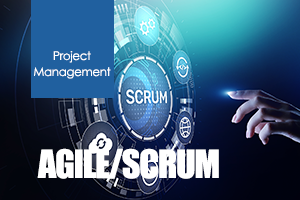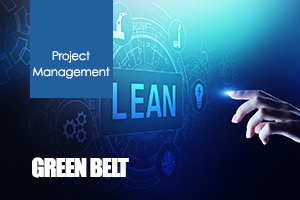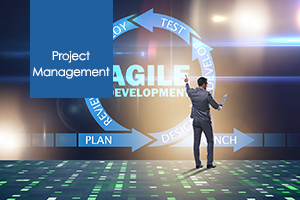
TBD |
|
15 Course Videos |
|
50 Test Questions |
Scrum is the most popular hybrid of AGILE it provides a framework that allows teams to address complex adaptive problems, while efficiently and creatively delivering products, services, or results of the highest possible value to their internal and external customers.
The Scrum framework improves project performance in three ways:
- Emphasis on communication between the team and stakeholders
- Timely feedback from stakeholders
- Safe and courageous environment within the team
In a Scrum environment, the team constantly communicate with their customers and fellow team members. The team keeps their design simple and clean. They get feedback by Scrum reviews at the end of each timeboxed scrum. They deliver the product, service, or result to the customers as early as possible, by focusing on high-value functionality in early scrums and implementing changes as suggested.
This emphasis on incremental delivery of high-value functionality creates an environment where small successes deepen customer and team respect for the unique contributions of all team members.
Scrum provides a simple framework for effective team collaboration on projects where there exists a great deal of uncertainty due to:
- Customer’s not really being sure of requirements
- The team possessing the necessary skill set, but the product, service or result has never been attempted by the team and the final product, service or result will need to be progressively elaborated
- Tenuous funding, and as such there needs to be a focus on a Minimum Viable Product (MVP) or a Minimum Marketable Feature (MMF) This course integrates LEAN principles, where applicable, with AGILE/Scrum. Lean is a business methodology, initially used to improve throughput in manufacturing, that is used in Adaptive Project Life Cycles to achieve more predictable delivery, greater efficiency, and a customer-centric mindset
Applying Lean principles to project management facilitates empowerment project team members to better clarity and deliver projects with an emphasis on delivering value to internal and external customers.
This course describes provides a basic understanding of AGILE/Scrum principles and tools and techniques used in implementing AGILE/Scrum in a coordinated fashion to ensure successful project outcomes.
- Agile Introduction Scrum
- Agile Core Principles Scrum
- Lean Product Development Scrum
- Agile Leadership Tasks Scrum
- Agile Communications Scrum
- Value Driven Delivery Scrum
- Value Driven Delivery Scrum Part2
- Stakeholder Engagement Scrum
- Facilitation Tools Scrum
- Team Performance Scrum
- Digital Tools for Distibuted Teams Scrum
- Adaptive Planning Scrum
- Adaptive Planning Scrum Part2
- Problem Detection and Resolution Scrum
- Continuous Improvement Scrum
Description
Scrum is the most popular hybrid of AGILE it provides a framework that allows teams to address complex adaptive problems, while efficiently and creatively delivering products, services, or results of the highest possible value to their internal and external customers.
The Scrum framework improves project performance in three ways:
- Emphasis on communication between the team and stakeholders
- Timely feedback from stakeholders
- Safe and courageous environment within the team
In a Scrum environment, the team constantly communicate with their customers and fellow team members. The team keeps their design simple and clean. They get feedback by Scrum reviews at the end of each timeboxed scrum. They deliver the product, service, or result to the customers as early as possible, by focusing on high-value functionality in early scrums and implementing changes as suggested.
This emphasis on incremental delivery of high-value functionality creates an environment where small successes deepen customer and team respect for the unique contributions of all team members.
Scrum provides a simple framework for effective team collaboration on projects where there exists a great deal of uncertainty due to:
- Customer’s not really being sure of requirements
- The team possessing the necessary skill set, but the product, service or result has never been attempted by the team and the final product, service or result will need to be progressively elaborated
- Tenuous funding, and as such there needs to be a focus on a Minimum Viable Product (MVP) or a Minimum Marketable Feature (MMF) This course integrates LEAN principles, where applicable, with AGILE/Scrum. Lean is a business methodology, initially used to improve throughput in manufacturing, that is used in Adaptive Project Life Cycles to achieve more predictable delivery, greater efficiency, and a customer-centric mindset
Applying Lean principles to project management facilitates empowerment project team members to better clarity and deliver projects with an emphasis on delivering value to internal and external customers.
This course describes provides a basic understanding of AGILE/Scrum principles and tools and techniques used in implementing AGILE/Scrum in a coordinated fashion to ensure successful project outcomes.
- Agile Introduction Scrum
- Agile Core Principles Scrum
- Lean Product Development Scrum
- Agile Leadership Tasks Scrum
- Agile Communications Scrum
- Value Driven Delivery Scrum
- Value Driven Delivery Scrum Part2
- Stakeholder Engagement Scrum
- Facilitation Tools Scrum
- Team Performance Scrum
- Digital Tools for Distibuted Teams Scrum
- Adaptive Planning Scrum
- Adaptive Planning Scrum Part2
- Problem Detection and Resolution Scrum
- Continuous Improvement Scrum
Additional information
TBD |
|
15 Course Videos |
|
50 Test Questions |
You may also like…
-
Read more
Agile Project Management
12 hours 5 minutes
41 Course Videos
147 Test Questions
The Agile Project Management course gives the basic of Agile with emphasis on the Scrum style This course also gives the... -
Read more
Six Sigma Green Belt

20 hours 26 minutes
55 Course Videos
59 Test Questions
A process is a means of creating and delivering products and services needed by customers According to Takashi Osada,...
-
Read more
Mastering Scrum

3 hours 22 minutes
32 Course Videos
45 Test Questions
A Certified Scrum Master helps project teams properly use Scrum, increasing the likelihood of the project’s overall...




